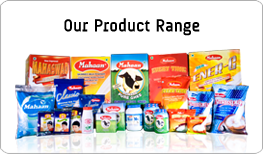Frequently Asked Questions
What is pasteurization?
Pasteurization refers to the process of heating each and every particle of milk to at least 63°C for 30 min (LTLT method) or 72°C for 15 sec (HTST) or to any approved temperature-time combination which is equally efficient in approved and properly operated equipment. Immediately after pasteurization, the milk is invariably cooled to 5°C or below.
How to detect adulterated milk (with water)?
Milk adulterated with water can be easily found out with an instrument called ‘lactometer���. The lactometer measures the specific gravity of milk. The average specific gravity of milk ranges (at 60°F) from 1.028 ��� 1.030 for cow milk and 1.030-1.032 for buffalo milk. Lower values than the standard given indicates that the milk is adulterated with water.
How much energy shall I get from 100gm of milk powder?
The energy value of milk varies with its composition. The details of energy value for each product have already been mentioned on the packs.
What is the difference between skim milk and whole milk?
It all depends upon the fat content of milk. Generally cow milk (whole milk) contains 4.0 to 4.5 % milk fat whereas buffalo milk contains up to 6.5% milk fat. Milk fat is the valuable portion of milk, based on which, milk is priced. When skimming is done to separate the fat by means of a cream separator, cream and skim milk having less than 0.5% milk fat is obtained from milk.
Do I need to refrigerate the ghee?
A well-prepared ghee has very little moisture content and it is shelf-stable if you keep it in an airtight container. When kept in refrigerator, ghee can last up to twelve to fifteen months.
How do I handle the opened jar?
Use a clean and dry spoon. Close the lid as soon as possible. Do not let any moisture get into your ghee jar.
I noticed that the texture is grainy rather than smooth. Is this a problem?
We believe the quality of ghee is the most important factor to get a grainy texture. The conventional store-bought ghee has a very uniform, smooth, highly consistent texture. A well-prepared ghee should have a grainy texture.
How the pack sizes of your different type of products are decided?
This is depending on the consumer demands and volume of sales based on the feedback from the market over the years.
What is the difference between low fat and high fat products? Why?
The difference lies in the fat content of the milk powder as mentioned on every pack.
This is done as per market demands and to satisfy requirements of every economic segment of consumers.How can I put my complaint or any suggestion to your organization?
We have mentioned our customer care number and email address on every pack.


